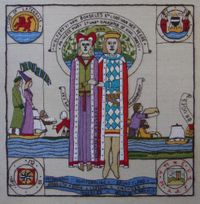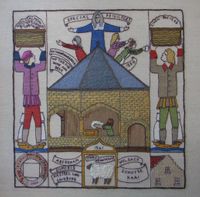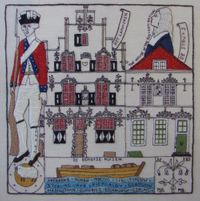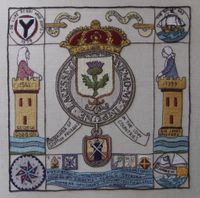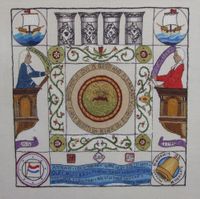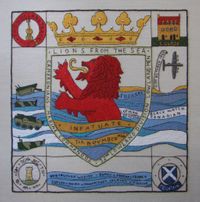Veere op het Scottish Diaspora Tapestry
In 2012 is vanuit Schotland een begin gemaakt met het ontwerp van een meterslang wandtapijt, dat de geschiedenis van de Schotten 'in diaspora' moet verbeelden, of de Schotse migratie door de eeuwen heen. Op diverse plaatsen in 34 landen waren gedurende enkele jaren vrijwilligers bezig met het borduren van de verschillende delen, de 'panels'. Veere kreeg er zes toebedeeld. Het initiatief was genomen door Dr. Gordon Wills, Baron of Prestongrange uit het Schotse Prestonpans. Museum De Schotse Huizen en de Stichting Veere-Schotland verleenden hieraan medewerking, samen met vele vrijwilligers voor het borduurwerk. De ontwerper van het tapijt is Andrew Crummy.
Op 29 september 2013 borduurde de ereconservator van Veere, Neil Wallace, de laatste steek van het wandtapijt. De Veerse delen zijn in Schotland samengevoegd met de panelen uit de overige 25 landen. Het tapestry was voor het eerst in zijn geheel te zien op de zgn. 'Gathering of the clans' die in 2014 in Schotland is gehouden; dat is een vijfjaarlijkse reünie (de ‘Homecoming celebrations’), die Schotten uit alle windstreken de gelegenheid biedt elkaar in een feestelijke ambiance te ontmoeten en bij te praten.
Daarna ging het tapijt reizen over alle deelnemende landen. Veere was de eerste locatie waar het tapestry in zijn geheel werd tentoongesteld. De hele zomer van 2015 stond in het teken van de historische betrekkingen tussen Veere en Schotland. Tijdens de expositie van het tapestry vonden diverse activiteiten plaats, waaronder een ‘diaspora-concert’ door Brian McNeill, rondleidingen langs het tapestry door de verhalenverteller Ewan McVicar, poppentheatervoorstellingen, een middeleeuws re-enactment evenement met een presentatie aan het volk van heer Wolfert van Borsele en zijn Schotse vrouw Mary Stuart, e.a.
Veere en het tapestry.
Waarom deed de stad Veere mee aan dit ‘Scottish Diaspora Tapestry’? Al meer dan 700 jaar is er een relatie tussen Veere en Schotland. De ligging aan zee en aan de monding van de Schelde was voor de ontwikkeling van de handel in Veere erg belangrijk. Vanaf de 13de eeuw deden Veerse vissers Schotse havenplaatsen aan. Sommige schippers werden zo rijk met deze handel, dat ze in de Walcherse steden handelskantoren oprichtten. Vanaf 1400 is sprake van Schotse handelaren die hun goederen in Zeeland afzetten. Graag wilden de middeleeuwse stadsbestuurders dat hun stad de enige opslagplaats van bepaalde koopwaren zou worden. Zo’n stad noemde men dan de Stapel. Veere kreeg in 1541 daadwerkelijk dat stapelrecht. Klik hier voor een toelichting bij de ontwerpen.
Scottish Dispora Tapestry: Telling tales of and to Scotland.
This magnificent and inspiring tapestry has been embroidered from 2012 up to 2014 in 34 countries across the globe to which Scots emigrated to create their diaspora. This artwork has been touring outwith Scotland until 2017 and has eventually returned to Prestonpans in East Lothian where it was designed and sponsored to provide both an enduring reminder of what millions of Scots achieved and a vital example of living history created for the young and old. The first complete exhibition of all 305 panels was opened on the 30th 2015 of May in Veere, in the presence of the British Ambassador to The Netherlands, Sir Geoffrey Adams, together with the Mayor of Veere Mr. Rob van der Zwaag and Veere’s honorary conservator Mr. Neil Wallace. This small Dutch town is unique in having a Conservator of Scottish Privileges in place to this day. There could be no more appropriate diaspora location. Veere has had in office since 1541 a Conservator of Scottish Privileges in The Netherlands although its commercial duties lapsed with the French Revolution in 1799. Click here for more information about the Veere panels. Scots have migrated all over the world and have often had a profound impact on the areas where they settled. This project has seen 34 such communities documenting their Scottish connections on a series of embroidered panels. Their combined stories will pay homage to the incredible determination and courage of Scots over the centuries.
The Netherlands was a pivotal trade hub during the middle ages, and a profitable maritime commerce between Scotland and the Low Countries. In particular Scottish traders brought wool, hides, and coal. Such traffic not only generates money, but also an exchange of peoples. Dutch communities developed in Scotland (particularly on the east coast which faced onto the trade routes) whilst Scottish communities developed in the Netherlands. Veere, which gained the Scottish wool staple, became the most prominent of the latter, but there was also a considerable Scots presence in other places such as Rotterdam. Trade and commerce created a stable environment for the development of academic links, and there was a tradition of Scots students attending Dutch instituitions. Many Scots attended the university at Leiden, a centre of Law and Medicine, and Scots could even be found teaching there in the seventeenth century. Between 1572 and 1800, 1,460 Scottish students are known to have attended Leiden – a considerable number in the days before accessible travel. Post-reformation Scots had a particular empathy with the Calvinists of the Dutch Republic, and a Scots International Church was established in Rotterdam in 1643 and remains open today. Trade and education were not the only factors, which drew Scots to the Netherlands. As in many parts of the Diaspora, war played its part as well. For example, large numbers of Scots fought in the wars, which saw the Netherlands gain independence from Spain, and after the wars three regiments stayed on as the Scots Brigade. They continued to serve in the Netherlands, wearing British-style uniforms and recruiting in Scotland, until war broke out between Britain and the Dutch Republic over the latter’s support for American Revolutionaries. When ordered to incorporate fully into the Dutch Army, the Brigade instead returned to Scotland as the 94th Regiment. www.scottishdiasporatapestry.org
